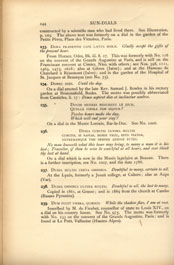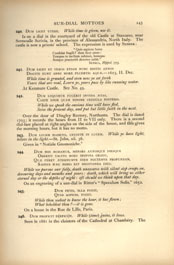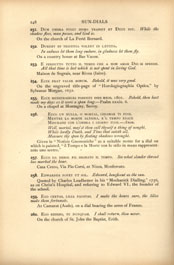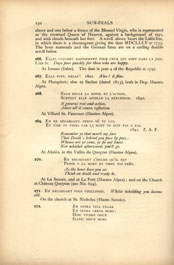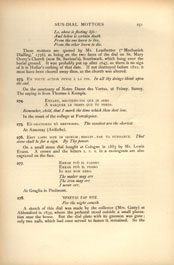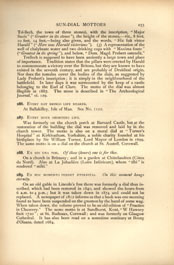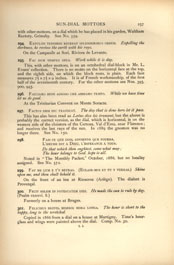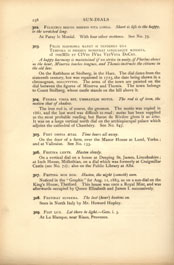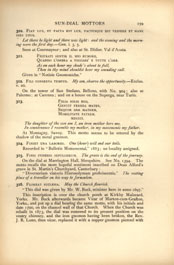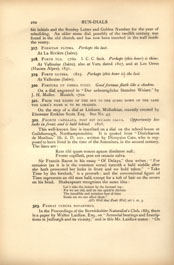Sun-Dial Mottoes (continued.)

[Full Image]
BARNES HALL, SHEFFIELD.
| 217. | DILIGE DOMINUM DEUM TOTO CORDE. Love the Lord thy God with all thy heart (Deut. vi. 5). At Moccas Court. See No. 1469. |
| 218. | DILIGENTIBUS PATRIAM FAUSTA. Happy this hour to them that love their country. At Eyguières (Bouches du Rhône). |
| 219. | DILIGITE DILIGENTIAM IN MUNERE VESTRO. Love diligence in your office. On the hospital at Milan. |
| 220. | DISCE BENE VIVERE ET MORI. Learn to live and die well. "Erected by the Corporation of Conway. Robert Wynne Jr Esq. Alderman; Hugh Williams & John Nuttall Bailiffs. 1761." On a pedestal dial in Conway churchyard. |
| 221. | DISCE DIES NUMERARE TUOS. Learn to number thy days. On an old school-house at Wortley, near Sheffield; at Dirtcar House, Wakefield, with No. 1172; and also on a large vertical stone dial in the kitchen garden at Barnes Hall, near Sheffield. The date upon this dial is 1738, and without doubt it was the handiwork of a very remarkable man, Samuel Walker, of Masbrough. He was of humble origin, born in the parish of Ecclesfield, and began life as a parish schoolmaster and a dial-maker. When fixing this identical dial at Barnes Hall, then occupied by Sir William Horton, that gentleman remarked to a friend, "Sam Walker will on day ride in his carriage." The words were prophetic, for in a few years Walker had laid the foundation of the largest ironworks in the country at Masbrough, near Rotherham, and his descendants have since occupied and still maintain a good position as country gentlefolk. See No. 248. The first three words of this motto, with the date 1744, are on the wall of Arundel Church, Sussex. |
| 222. | DISCE MORI MUNDO. Learn to die to the world. Seen on Batley church porch, Yorkshire, in 1879. |
| 223. | DISCITE JUSTITIAM, MONITI. Learn justice, being warned. This motto, from Virgil, Æn. vi. 620, is on a dial in the Middle Temple. Professor Beckmann, in his "History of Inventions and Discoveries," says: "On the side of New Palace Yard, which is opposite |
to Westminster Hall, and in the second pediment of the new buildings from the Thames, a dial is inserted with this remarkable motto upon it: Discite justitiam moniti, which seems most clearly to relate to the fine imposed on Radulphus de Hengham being applied to the paying for a clock." The professor proceeds to state that the dial was fixed exactly where Strype describes the clock-house to have stood. Blackstone tells the well-known story, how Chief Justice Ralph Hengham – "a very learned judge to whom we are obliged for two excellent treatises of practice" – out of mere compassion for a very poor man, altered a fine of 13s. 4d. to 6s. 8d., and was consequently fined 800 marks by King Edward I., which were expended in building a clock-house to regulate the sittings of the Courts. This sovereign, who has been styled the Justinian of England, did so much to reform the Courts, that Sir Matthew Hale says, "that more was done in the first thirteen years of his reign to settle and establish the distributive justice of the kingdom, than in all the ages since that time put together." We may consider that the present clock tower at Westminster, from which "Big Ben" gives forth his loud utterances, is a more than sufficient substitute for that which Judge Hengham's name is associated. |
|
| 224. | DISEGNA LE ORE SENZA FAR ROMORE. A silent sign denotes the hour. Seen on the Italian Custom House at Fornasette, in 1866, with No. 175. Adopted in 1899 for a dial erected by George W. Sidebotham, Esq., M.D., at Broughton Astley Hall, Leicestershire. He has designed and calculated the dial, and inclined the plate so as to allow the gnomon, which is at right angles to it, to correspond with the latitude. The dial faces north, and XII (noon) is at the lowest point. In the outer circle, opposite the names indicating the degrees of longitude, appear the names of a number of places, most of which were visited by Dr. and Mrs. Sidebotham during a recent tour round the world. The chief interest of the dial is this, that if at any given time they wish to know what o'clock it is at some other place named in the circle, all that need be done is to rotate the dial until the named place reaches the zero mark, when the shadow gives the required hour. |
| 225. | DIVIDIT UMBRA DIEM. The shadow divides the day. Given in "Notizie Gnomoniche." |
| 226. | DO, SI SOL. I give (the hour) if the sun (does). On the façade of the Château d'Agnelas (Isère). |
| 227. | DO TO-DAY'S WORK TO-DAY. 1875. Placed on a dial at Golder's Hill, Hampstead, by the late Sir Spencer Wells, Bart. In connection with this motto we may recall a saying of the Duke of Wellington recorded by Earl Stanhope: "We |
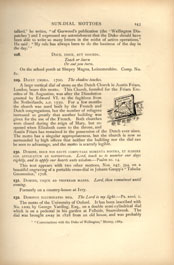
[Full Image]
Docet Umbra
talked," he writes, "of Gurwood's publication (the 'Wellington Dispatches') and I expressed my astonishment that the Duke should have been able to write so many letters in the midst of active operations." He said: "My rule has always been to do the business of the day in the day." 1 |
|
| 228. | DOCE, DISCE, AUT DISCEDE
Teach or learn Or out you turn. On the school porch at Shepey Magna, Leicestershire. Comp. No. 81. |
| 229. | DOCET UMBRA. 1700. The shadow teaches. A large vertical dial of stone on the Dutch Church in Austin Friars, London, bears this motto. This Church, founded for the Friars Eremites of St. Augustine, was after the Dissolution granted by Edward VI. to the fugitives from the Netherlands, A.D. 1550. For a few months the church was used both by the French and Dutch congregations, but the number of refugees increased so greatly that another building was given for the use of the French. Both churches were closed during the reign of Mary, but re-opened when Elizabeth came to the throne, and Austin Friars has remained in the possession of the Dutch ever since. The motto has a singular appropriateness, but the church is now so surrounded by high offices that neither the building nor the dial can be seen to advantage, and the motto is scarcely legible. |
| 230. | DOMINE, DOCE NOS RECTE COMPUTARE MOMENTA NOSTRA, ET HABERE COR APPLICATUM AD SAPIENTIAM. Lord, teach us to number our days rightly, and to apply our hearts unto wisdom. – Psalm xc. 14. This text appears with two other mottoes, Nos. 247, 394, on a beautiful engraving of a portable cross-dial in Johann Gaupp's "Tabulæ Gnomonicæ," 1708. |
| 231. | DOMINE, USQUE AD VESPERAM MANES. Lord, thou remainest until evening. Formerly on a country-house at Ivry. |
| 232. | DOMINUS ILLUMINATIO MEA. The Lord is my light. – Ps. xxvi. I. The motto of the University of Oxford. It has been inscribed with No. 1200, by George Yarding, Esq., on a double semi-cylindrical dial which is on a pedestal in his garden at Fellside, Snaresbrook. The dial was brought away in 1828 from an old house, and was probably |
1 "Conversation with the Duke of Wellington," Murray, 1889.
constructed by a scientific man who had lived there. See Illustration, p. 105. The above test was formerly on a dial in the garden of the Petits Pères, Place des Victoires, Paris. |
|
| 233. | DONA PRÆSENTIS CAPE LÆTUR HORÆ. Gladly accept the gifts of the present hour. From Horace, Odes, Bk. iii. 8, 27. This was formerly with No. 116 on the convent at Grands Augustins at Paris, and is still on the Franciscan convent at Cimiez, Nice, with others; see Nos. 598, 1111, 1463, 1475, 1618; also Gières (Isère); and at the Hameau de Chatelard à Réaumont (Isère); and in the garden of the Hospital of St. Jacques at Besançon (see No. 75). |
| 234. | DONEC DIES. Until the day. On a dial erected by the late Rev. Samuel J. Bowles in his rectory garden at Beaconsfield, Bucks. The motto was possibly abbreviated from Canticles, ii. 17: Donec aspiret dies et inclinetur umbræ. |
| 235. | DOUZE HEURES MESURENT LE JOUR, On a dial in the Musée Lorrain, Bar-le-Duc. See No. 1006. |
| 236. |
No man knoweth what this hour may bring, to many a man it is his last; Traveller, if thou be wise be watchful at all hours, and ever think thy last at hand. On a dial which is now in the Musée lapidaire at Beaune. There is a futher inscription, see No. 1007, and the date 1786. |
| 237. | DUBIA MULTIS CERTA OMNIBUS. Doubtful to many, certain to all. At the Lycée, formerly a Jesuit college, at Cahors; also at Aups (Var). |
| 238. | DUBIA OMNIBUS ULTIMA MULTIS. Doubtful to all, the last to many. Copied in 1861, at Grasse; and in 1869 from the church at Cambo (Basses Pyrenées). |
| 239. | DUM FUGIT UMBRA, QUIESCO. While the shadow flees, I am at rest. Inscribed by M. de Fieubet, counsellor of state to Louis XIV., on a dial on his country house. See No. 975. The motto was formerly with No. 233 on the convent of the Grands Augustins, Paris; and is found at Le Poët, Vallouise (Hautes Alpes). |
| 240. | DUM LICET UTERE. While time is given, use it. Is on a dial in the courtyard of the old Castle at Stazzano, near Serravalle Scrivia, in the province of Alessandria, North Italy. The castle is now a priests' school. The expression is used by Seneca:
"Quis sapiens bono SENECA, Hippol. 775. |
| 241. | DUM LICET ET VEROS ETIAM NUNC
EDITIS ANNOS
While time is granted, and even now ye set forth At Kenmure Castle. See No. 49. |
| 242. | DUM LOQUIMUR FUGERIT
INVIDA ÆTAS,
While we speak the envious time will have fled, Over the door of Dingley Rectory, Northants. The dial is dated 1703; it records the hours from II to VII only. There is a second dial-face placed at right-angles on the side of the house, and this gives the morning hours, but it has no motto. |
| 243. | DUM LUCEM HABETIS, CREDITE IN LUCEM. While ye have light, believe in the light. – St. John, xii. 36. Given in "Notizie Gnomoniche." |
| 244. | DUM NOS MORAMUR,
MENSES ANNOSQUE DIESQUE
While we pursue our folly, death unawares with silent step creeps on, devouring days and months and years: death, which will bring us either eternal day or the depths of night: oft should we think upon the day. On an engraving of a sun-dial in Ritter's "Speculum Solis," 1652. |
| 245. | DUM PETIS, ILLA FUGIT,
While thou seekest to know the hour, it has flown; On a house in the Rue de Lille, Paris. |
| 246. | DUM PROFICIT D(EFICI)T. While (time) gains, it loses. Seen in 1861 in the cloisters of the Cathedral at Chambéry. The |
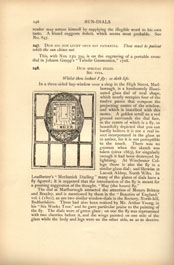
[Full Image]
Dum Spectas Fugio.
| reader may amuse himself by supplying the illegible word to his own taste. A friend suggests deficit, which seems most probable. See No. 847. | |
| 247. | DUM SOL NON LUCET OPUS EST PATIENTIA. Thou must be patient while the sun shines not. This, with Nos. 230, 394, is on the engraving of a portable cross-dial in Johann Gaupp's "Tabulæ Gnomonicæ," 1708. |
| 248. | DUM SPECTAS FUGIO. Whilst thou lookest I fly; so doth life. In a three-sided bay-window over a shop in the High Street, Marlborough, is a handsomely illuminated glass dial of oval shape, which nearly occupies four of the twelve panes that compose the projecting centre of the window, and which is inscribed with this motto. A golden scroll on a red ground surrounds the dial face, in the centre of which is a fly, so beautifully depicted that you can hardly believe it is not a real insect incorporated in the glass as in amber, for it is not perceptible to the touch. There was no gnomon when the sketch was taken (circa 1863), for singularly enough it had been destroyed by lightning. At Winchester College there is also the fly in a similar glass dial; and likewise at Lacock Abbey, North Wilts. In Leadbetter's "Mechanick Dialling" many of the plates of dials have a fly figured; it is supposed that the introduction of the fly is meant for a punning suggestion of the thought, "May (the hours) fly." The dial at Marlborough attracted the attention of Messrs Britton and Brayley, and is mentioned by them in the "Beauties of England," vol. i. (1801), as are two similar window-dials in the Rectory, North-hill, Bedfordshire. These had also been noticed by Mr. Arthur Young, in his "Six Weeks Tour," and he gave particular praise to the painting of the fly. The dials were of green glass; on one the fly was represented with two cherries before it, and the wings painted on one side of the glass while the body and legs were on the other side, so as to deceive |
the spectator. The dials bore the mottoes Dum spectas fugio, and Sic transit gloria mundi, and on one of them, "John Oliver, fecit 1664." As the rectory at North-hill had lately been rebuilt, and the paintings were described by Mr. Britton as lying useless, it is probable that they no longer exist. Dum spectas fugio is on a window-dial described in the "Strand Magazine," in 1892, as being in Mr. E. P. Johnson's office, Derby. A bird and a fly are in the centre. It was made in 1888 by Frederick Drake, Glazier, Exeter, and copied from one taken out of an old Devonshire manor house. The same motto, with the date 1739, was on one of four vertical dials which surmounted a short column standing on a step in the garden of "The Holmes," Rotherham. On the step is inscribed the name of the maker, Saml. Walker, fecit. See No. 221. Dum spectas fugio may be read on a dial which adorns an old gabled entrance to one of the canons' houses at Exeter. It is supported by a small stone figure, and is placed between two mullioned windows, above which is a medallion of Queen Elizabeth. Over the arched doorway is a coat of arms, and the words "Vincit Veritas." The motto is inscribed on a dial in the churchyard of Cranbrook, Kent, with "John Hague and Ellis Troughton, 1855; on the farmhouse of Greenbury in the parish of Scorton, Yorkshire, with "J. Fawcitt" 1751, the "i" in fugio being omitted by mistake. It was formerly on the market house at King's Lynn, with Nos. 745, 1109, 1167; and is still, we hope, at Ripley, in Surrey (see No. 1002); and Thorp Perrow, with No. 1396. At Kirkby in Cleveland, a dial dated 1815 once bore it, but in 1887 the motto was found to be almost obliterated. Dum spectas fugio has also been read on Ingleton Church, Yorkshire; and on the old tower of Willesden Church, with the date 1736. |
|
| 249. | DUM SPECTAS FUGIT. Whilst thou art looking (the hour) is flying. Formerly on Felkirk Church, Yorkshire, dated 1769, but in 1884 the dial had fallen to the ground in a gale. The motto is on the parish church, Leighton Buzzard (see No. 101); and on St. Patrick's Church, Isle of Man (see No. 864). It is also on Heighington Church, co. Durham, with the additional work hora; and on a house at Walsingham ending with carpe diem. |
| 250. | DUM TEMPUS HABEMUS OPEREMUR BONUM. While we have time let us do good. – Gal. vi. 10. On the Convent of the Annunziata, Florence; and with No. 1450 in the courtyard of the Evêché, Blois. Also on the south dial of the pillar at Tytherton Kellaways, Wilts (see No. 1619), with the following paraphrase, composed by the Rev. W. L. Bowles: Life steals away; O man, this hour is lent thee, |
| 251. | DUM UMBRA FUGIT HOMO TRANSIT ET DEUS EST. While the shadow flees, man passes, and God is. On the church of La Ferté Bernard. |
| 252. | DURENT IN TRISTITIA
VOLENT IN LÆTITIA.
On a country house at Bas Vacon. |
| 253. |
E
PERDUTTO TUTTO IL TEMPO CHE A NON
AMAR DIO
SI SPENDE.
Maison de Segrais, near Rives (Isère). |
| 254. | ECCE ERAT VALDE BONUM. Behold, it was very good. On the engraved title-page of "Horologiographia Optica," by Sylvanus Morgan, 1652. |
| 255. |
ECCE MENSURABILES POSUISTI
DIES MEOS. 1801. On a chapel at Montagny, Savoy. |
| 256. |
ECCO UN NULLA, O MORTAL, CHIAMAR TI PUOI,
Given in "Notizie Gnomoniche" as a suitable motto for a dial on which is painted, "il Tempo e la Morte con lo stilo in mano rappresentante uno scetro." |
| 257. |
ECCO DA DEBOL FIL SEGNATO IL TEMPO.
Casa Cecco, Via Pio Corsi, at Nizza, Monferrato. |
| 258. | EDWARDUS FOVET UT SOL. Edward, beneficent as the sun. Quoted by Charles Leadbetter in his "Mechanick Dialling," 1756, as on Christ's Hospital, and referring to Edward VI., the founder of the school. |
| 259. | EGO CERTAS, LILIA FAUSTAS. I make the hours sure, the lilies make them fortunate. At Camurat (Aude), on a dial bearing the arms of France. |
| 260. | EGO REDIBO, TU NUNQUAM. I shall return, thou never. On the church of St. John the Baptist, Erith. |
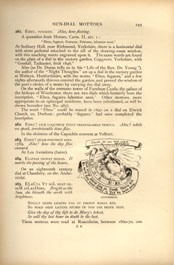
[Full Image]
ROSENHEIM.
| 261. | EHEU, FUGACES. Alas, how fleeting. A quotation from Horace, Carm. II. xiv. I: "Eheu, fugaces, Postume, Postume, labuntur anni." At Sedbury Hall, near Richmond, Yorkshire, there is a horizontal dial with stone pedestal attached to the sill of the drawing-room window, with this touching motto engraved upon it. The same words are found on the plate of a dial in the rectory garden, Copgrove, Yorkshire, with "Goodall, Tadcaster, fecit 1846." Also (as Dr. Doran tells us in his "Life of the Rev. Dr. Young"), the author of the "Night Thoughts" set up a dial in the rectory garden at Welwyn, Hertfordshire, with the motto, "Eheu, fugaces," and a few nights afterwards thieves entered the garden, and proved the wisdom of the poet's choice of a motto by carrying the dial away. On the walls of the entrance tower of Farnham Castle, the palace of the bishops of Winchester, there are two dials which formerly bore the inscription, "Eheu, fugaces labuntur anni." Other mottoes, more appropriate to an episcopal residence, have been substituted, as will be shown hereafter (see No. 987). The word "Eheu" could be traced in 1890 on a dial on Elwick Church, co. Durham; probably "fugaces" had once completed the inscription. |
| 262. | EHEU! DUM LOQUIMUR FUGIT IRREPARABILE TEMPUS. Alas! while we speak, irretrievable time flies. In the cloisters of the Capuchin convent at Velletri. |
| 263. | EHEU! QUAM FESTINAT DIES. 1789. Alas! how the day flies onward. At Les Avenières (Isère). |
| 264. | ELAPSAS SIGNAT HORAS. It marks the passing of the hours. On an eighteenth century dial at Chambéry, on the Archevêché. |
| 265. | ELECTA VT SOL BEAT ORBEM SPLENDORE. Bright as the Sun, she blesseth the earth with brightness. STELLT DEINS LEBENS TAG ZU DIENST MARIA EIN, These mottoes were read at Rosenheim, between 1860-70, one |
above and one below a fresco of the Blessed Virgin, who is represented as the crowned Queen of Heaven, against a background of rays and with clouds beneath her feet. A scroll above bears the Latin line, in which there is a chronogram giving the date MDCLLLV = 1755. The hour numerals and the German lines are on a curling double scroll below. |
|
| 266. | ELLES COULENT RAPIDEMENT POUR CEUX QUI SONT DANS LA JOIE. L'an iv. Days pass quickly for those who are happy. At Izeaux (Isère). The date is year 4 of the Republic = 1797. |
| 267. | ELLE FUIT, HÉLAS! 1801. Alas! it flies. At Plampinet; also at Sachat (dated 1813), both in Dep. Hautes Alpes. |
| 268. |
ELLE RÉGLE LA REPOS ET L'ACTION, At Villard St. Pancrace (Hautes Alpes). |
| 269. |
EN ME REGARDANT, PENSE OÙ TU VAS,
1841. Z. A. F. Remember ye that mark my face At Abriès, in the Vallée du Queyras (Haute Alpes). |
| 270. | EN REGARDANT L'HEURE QU'IL EST At La Bessée, and at Le Poët (Haute Alpes); and on the Church at Château Queyras (see No. 694). |
| 271. | EN REGARDANT VOUS VIEILLISSEZ. Whilst beholding you become old. On the church at St. Nicholas (Haute Savoie). |
| 272. | EN SUPRA VITA FUGAX |
Lo, above is fleeting life: These mottoes are quoted by Mr. Leadbetter ("Mechanick Dialling," 1756), as being on the two faces of the dial on St. Mary Overy's Church (now St. Saviour's), Southwark, which hung over the burial ground. It was probably put up after 1647, as there is no sign of it in Hollar's etching of that date. If not destroyed before 1822, it must have been cleared away then, as the church was altered. |
|
| 273. | EN TOUTE ACTION PENSE À LA FIN. In all thy doings think upon the end. On the sanctuary of Notre Dame des Vertus, at Peisey, Savoy. The saying is from Thomas à Kempis. |
| 274. |
ENFANT, SOUVIENS-TOI QUE JE SERS
In the court of the college at Forcalquier. |
| 275. | EÒ GRATIORES EÒ BREVIORES. The sweetest are the shortest. At Annonay (Ardèche). |
| 276. | ERIT LAPIS ISTE IN SIGNUM . MDCCIV . PAR TA PUISSANCE. That stone shall be for a sign. By Thy power. On a small stone dial bought at Cologne in 1885 by Mr. Lewis Evans. A crown and the letters L. P. B. in a monogram are also engraved on the face. |
| 277. | ERRAR PUÒ IL FABBRO At Graglia in Piedmont. |
| 278. | 'EPXETAI ΓAP NϒΞ. A sketch of this dial was made by the collector (Mrs. Gatty) at Abbotsford in 1839, where the pedestal stood outside a small plantation near the house. But the dial plate with its gnomon was gone; only two nails, which had once served to fasten it, remained. So the |

[Full Image]
ABBOTSFORD.
motto had been a prophecy; for the dial's work was over, since it could henceforth record nothing, except that the night was coming – which, indeed, had come as if in mockery of itself. One could not help thinking further of the night that came down upon Abbotsford when its illustrious master was lost to the world. The motto was also adopted by Dr. Johnson, as we learn from the following passage in Boswell: "At this time I observed upon the dial-plate of his (Dr. Johnson's) watch a short Greek inscription, taken from the New Testament, Nὺξ γὰρ ἔρχεται being the first words of our Saviour's solemn admonition to the improvement of that time which is allowed to us to prepare for eternity – 'The night cometh when no man can work.' He sometime afterwards laid aside this dial plate, and when I asked him the reason, he said, "It might do very well upon a clock which a man keeps in his closet; but to have it upon his watch which he carries about with him and which is looked at by others, might be censured as ostentatious.'" Croker adds in a note: "The inscription, however, was made unintelligible by the mistake of putting νμξ for νὺξ. We would observe that this error is quite sufficient to account for the learned scholar putting aside his watch, and we know that he did not always condescend to fully enlighten his shadow, "Bozzy," as to his motives. It is also remarkable that in both cases the word γαρ should have been introduced, for it is not in the New Testament. Probably, however, Sir Walter copied the passage from Johnson without referring to the original. With the beautiful candour which belongs to his character and marks the brief autobiography prefixed to Lockhart's life of him, Sir Walter Scott confesses that when he went to the college at Edinburgh he had no knowledge of the Greek language, and adds, "I forgot the very letters of the Greek alphabet." His comment on his own ignorance cannot be too often repeated: "If it should ever fall to the lot of youth to peruse these pages, let such a reader remember that it was with the deepest regret that I recollect in my manhood the opportunities of learning which I neglected in my youth; that through every part of my literary career I have felt pinched and hampered by my own ignorance; and that I would at this moment give half the reputation I have had the good fortune to acquire, if by so doing I could rest the remaining part upon a solid foundation of learning and science." The same quotation ᾽EPXETAI NϒΞ, rightly rendered, is to be found as a motto upon the plate of a horizontal dial in the beautiful grounds of Dromore Castle, co. Kerry, inscribed by the late owner, R. Mahony, Esq., |
in 1871, when the dial was erected. Nὺξ γὰρ ἔρχεται is with other mottoes on a dial at the House of Mercy, Horbury, Yorks. See No. 1629. |
|
| 279. | ES OURO (C'EST L'HEURE). It is time. In the Provençal dialect, given by Baron di Rivière, but without locality. |
| 280. | EST DEO GRATIA. Thanks are to God. EST REPOSITA JUSTITIÆ CORONA. There is laid up a crown of righteousness (2 Tim. iv. 8). (See illustration, p. 119.) These mottoes, with Nos. 360, 981, are inscribed round the moulding above the capital of the dial pillar at Corpus Christi College, Oxford. It stands in the quadrangle, a pillar surmounted by a cubical capital, above which is a pyramidal block of stone, with a dial face on each side, and this is crowned by a pelican on a globe, the crest of the college. On the four sides of the cube are four coats of arms carved in relief, viz.: (1) those of Bishop Fox, the founder of the College; (2) of Bishop Oldham; (3) of the University; (4) the Royal arms. In each case the scroll work round the shield acts as a gnomon to a dial face engraved below it. On the cylindrical shaft there is a fifth dial face, with a perpetual calendar engraved below it, and near the base is another motto, HORAS OMNES COMPLECTA. The initials C. T. and two dates, 1581 and MDCV, the latter date being probably that of the tables on the shaft, and the former that of the construction of the dial by Charles Turnbull, a member of the college, a Lincolnshire man, and the author of a treatise on the use of the celestial globe. The dial is described in a MS. work by Robert Hegge, written 1625-30, now in the College Library (see p. 119), and his drawing is reproduced in the Rev. T. Fowler's "History of Corpus Christi College." In this sketch "the octagonal base of the cylinder rests on a platform and is approached by four steps and surrounded with rails. The present square pedestal is not figured." The pillar is said to have been regarded as "inconvenient," during the old days of threatened invasion, when the quadrangle was used as a drilling ground, but happily it was not removed from its place and still stands as a memorial of Turnbull's mathematical skill. The four mottoes on the pyramid are adapted from the Vulgate. |
| 281. | ESTEEM THY PRECIOUS TIME An incorrect version of No. 1074, in the same neighbourhood. The above is on one face of a cube of stone, bearing three dials on the other three faces, crowned with a ball and mounted on a stone column which stands on Wilton Bridge, near Ross, Herefordshire. It probably dates from the eighteenth century. |
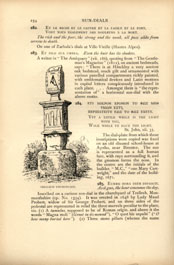
[Full Image]
TRELLECH CHURCHYARD.
| 282. |
ET LE RICHE ET LE PAUVRE ET
LA FAIBLE ET LE FORT,
The rich and the poor, the strong and the weak, all pass alike from sorrow to death. On one of Zarbula's dials at Ville-Vieille (Hautes Alpes). |
| 283. | ET PILO SUA UMBRA. Even the hair has its shadow. A writer in "The Antiquary" (vii. 186), quoting from "The Gentleman's Magazine" (1811), on ancient bedsteads, says: "There is at Hinckley a very ancient oak bedstead, much gilt and ornamented with various panelled compartments richly painted, with emblematical devices and Latin mottoes in capital letters conspicuously introduced in each place.... Amongst them is "the representation of" a horizontal sun-dial with the above motto. |
| 284. |
ETI
MIKPON XPONON TO
ΦΩΣ
MEΘ
TMΩN
EΣTI,
YET A
LITTLE WHILE IS THE LIGHT WITH YOU,
St. John, xii. 35. The dial-plate from which these inscriptions were copied was fixed on an old disused school-house at Aynho, near Bicester. The sun is represented as a full human face, with rays surrounding it, and the gnomon forms the nose. In the centre are the initials of the builder, "M.C.," "one Mary Cartwright," and the date of the building, 1671. |
| 285. |
EUNDO HORA DIEM DEPASCIT.
Inscribed on a curious sun-dial in the churchyard of Trellech, Monmouthshire (cp. No. 1334). It was erected in 1648 by Lady Maud Probert, widow of Sir George Probert, and on three sides of the pedestal are represented in relief the three marvels peculiar to the place, viz. (1) A tumulus, supposed to be of Roman origin, and above it the words "Magna moli" (Great in its mound"), "O quot hic sepulti" ("O how many buried here"). (2) Three stone pillars (whence the name |
Tri-llech, the town of three stones), with the inscription, "Major Saxis" ("Greater in its stones"), the height of the stones, – viz., 8 feet, 10 feet, 14 feet, – being also given, and the words, "Hic fuit victor Harald" ("Here was Harald victorious"). (3) A representation of the well of chalybeate water and two drinking cups with "Maxima fonte" ("Greatest in its spring"), and below, "Dom. Magd. Probert ostendit." Trellech is supposed to have been anciently a large town and place of importance. Tradition states that the pillars were erected by Harald to commemorate a victory over the Britons, but they are known to have existed in the seventh century, and are probably of Druidical origin. Nor does the tumulus cover the bodies of the slain, as suggested by Lady Probert's inscription; it is simply in the neighbourhood of the battlefield. In later days it was surmounted by the keep of a castle belonging to the Earl of Clare. The motto of the dial was almost illegible in 1887. The stone is described in "The Archæological Journal," xi. 129. |
|
| 286. | EVERY DAY BRINGS LIFE NEARER. At Ballakilley, Isle of Man. See No. 1122. |
| 287. | EVERY HOUR SHORTENS LIFE. Was formerly on the church porch at Barnard Castle, but at the restoration of the building the dial was removed and laid by in the church tower. The motto is also on a mural dial at "Turner's Hospital" at Kirkleatham, Yorkshire, a noble charity founded at his birthplace by Sir William Turner, Lord Mayor of London in 1699. The same motto is on a dial on the church at St. Austell, Cornwall. |
| 288. | EX HIS UNA TIBI. Of these (hours) one is for thee. On a church in Brittany; and in a garden at Châtelaudren (Côtes du Nord). Also at La Johadière (Loire Inférieure), where "tibi" is rendered "mihi." |
| 289. | EX HOC MOMENTO PENDET ÆTERNITAS. On this moment hangs eternity. On an old gable in Lincoln's Inn there was formerly a dial thus inscribed, which had been restored in 1840, and showed the hours from 6 a.m. to 4 p.m.; but it was taken down in 1874 and could not be replaced. A newspaper of 1812 informs us that a book was one morning found to have been suspended on the gnomon by the hand of some wag. When taken down, the volume proved to be an old edition of "Practice in Chancery." The same motto is at Sandhurst, Kent, "W Hawney fecit 1720"; at St. Budeaux, Cornwall; and was formerly on Glasgow Cathedral. It has also been read on a sometime seminary at Bourg d'Oisans, dated 1684. |
| 290. | EX UNDIS EMERGUNT IN AURAS. From the waters they rise into the air. In the Conservatoire des Arts et Métiers, Paris; on a sculptured stone dial, probably intended for the centre of a fountain. |
| 291. |
EΞAΓOPAZOMENOI
TON KAIPON OTI AI HMEPAI ΠONHPAI EIΣI.
In the Albert Park, Middlesbrough. See No. 97. |
| 292. | EXPECTO DONEC VENIAT ILLUMINATIO MEA I await the coming of my light, that I with the others may be strong to serve. This was inscribed on the north side of a casket-shaped dial of brass silvered and gilt, which was offered for sale in London, in 1898. It measured 4 in. in height, x 8 ½ x 6 in. at the base, and 5 ½ x 3 ½ in. at the lid. On the top and four sloping sides were five dials, showing both the Italian and the ordinary hours, the gnomons represented by boyish figures, and the shadow cast by an outstretched finger of the hand. About the figures are scrolls on which mottoes are engraved. That on the south side is: "Vespere cum eis pariter et mane in eodem die ostendere non deferam." At evening, as the others do, and in the morning likewise, I shall not delay to tell my tale. On the east: "A solis ortu usque ad meridiem intervalla ipsa diei aeque denuncio." From sunrise till noon I announce at equal periods the divisions of the day. On the west: " (A') meridie usque ad solis occasum itaque cum illa gradior." Like the last my steps I take from noon to sunset. In addition to these four mottoes there are inscriptions inside the lid, and outside the hinged flap, giving the initials of the maker, A. Æ. V., and the name of the owner, and the date, 1770: "ad latitud Napolis Grad: 40, 50." Also a description of the use of the instrument, and inside the casket there is a compass and plumbline fastened to two cross bars. |
| 293. | EXPLEBO NUMERUM REDDARQUE TENEBRIS. I shall complete the number of my days, and be restored to the shades. From the "Æneid," vi. 545, inscribed by the Rev. W. Tuckwell, |
with other mottoes, on a dial which he has placed in his garden, Waltham Rectory, Grimsby. See No. 559. |
|
| 294. | EXPULSIS TENEBRIS RECREAT SPENDORIBUS ORBEM. Expelling the darkness, he revives the earth with his rays. On the Campanile at Sori, Riviera de Levante. |
| 295. | FAC DUM TEMPUS OPUS. Work while it is day. This, with other mottoes, is on an octohedral dial-block in Mr. L. Evans' collection. There is no motto on the horizontal face at the top, and the eighth side, on which the block rests, is plain. Each face measures 7 ½ x 7 ½ x 9 inches. It is of French workmanship, of the first half of the seventeenth century. For the other mottoes see Nos. 395, 900, 945. |
| 296. | FACCIAMO BENE ADESSO CHE ABBIAMO TEMPO. While we have time let us do good. At the Trinitarian Convent on the Monte Soracte. |
| 297. | FACTUS DIES HIC TRANSEAT. The day that is done here let it pass. This has also been read as Lætus dies hic transeat, but the above is probably the correct version, as the dial, which is horizontal, is on the western side of the cloisters of the Certosa, Val d'Ema, near Florence; and receives the last rays of the sun. In 1889 the gnomon was no longer there. See No. 150. |
| 298. |
Noted in "The Monthly Packet," October, 1886, but no locality assigned. See No. 572. |
| 299. | FAY ME LUM E T'Y BEYRAS. (ECLAIR-MOI ET TU Y VERRAS.) Shine upon me, and thou shalt behold it. On the front of an inn at Rieucros (Ariège). The dialect is Provençal. |
| 300. | FECIT SOLEM IN POTESTATEM DIEI. He made the sun to rule by day. (Psalm cxxxvi. 8.) Formerly on a house at Bruges. |
| 301. | FELICIBUS BREVIS, MISERIS HORA LONGA. The hour is short to the happy, long to the wretched. Copied in 1866 from a dial on a house at Martigny. Time's hour-glass and wings were painted above the dial. Comp. No. 30. |
| 302. | FELICIBUS BREVIS MISERIS VITA LONGA. Short is life to the happy, to the wretched long. At Paray le Monial. With four other mottoes. See No. 75. |
| 303. | FELIX HARMONIA MANET SI TENDIMUS UNA
A happy harmony is maintained if we strive in unity, if Phœbus shows us the hour, Minerva teaches tongues, and Themis instructs the citizens in the old law. On the Rathhaus at Stolberg, in the Harz. The dial dates from the sixteenth century, but was repainted in 1723, the date being shown in a chronogram, MDCCVVVVIII. The arms of the town are painted on the dial between the figures of Minerva and Themis. The town belongs to Count Stolberg, whose castle stands on the hill above it. |
| 304. | FERREA VIRGA EST, UMBRATILIS MOTUS. The rod is of iron, the motion that of shadow. The iron rod is, of course, the gnomon. The motto was copied in 1861, and the last word was difficult to read; motus has been supplied as the most probable reading, but Baron de Rivière gives it as ictus. It was on a large vertical north dial on the archiepiscopal palace which adjoins the cathedral of Chambéry. See No. 847. |
| 305. | FERT OMNIA ÆTAS. Time bears all away. On the door of a farm, over the Manor House at Lund, Yorks.; and at Vallouise. See No. 133. |
| 306. | FESTINA LENTE. Hasten slowly. On a vertical dial on a house at Deeping St. James, Lincolnshire; at Inch House, Midlothian, on a dial which was formerly at Craigmillar Castle (see No. 72); also on the Public Library at Albi. |
| 307. | FESTINA MOX NOX. Hasten, the night (cometh) soon. Noticed in the "Graphic" for Aug. 11, 1883, as on a sun-dial on the King's House, Thetford. This house was once a Royal Mint, and was afterwards occupied by Queen Elizabeth and James I. successively. |
| 308. | FESTINAT SUPREMA. The last (hour) hastens on. Seen in North Italy by Mr. Howard Hopley. |
| 309. | FIAT LUX. Let there be light. – Gen. i. 3. At La Blanque, near Riaus, Provence. |
| 310. | FIAT LUX, ET FACTA EST LUX, FACTUSQUE EST VESPERE ET MANE DIES UNUS. Let there be light and there was light: and the evening and the morning were the first day. – Gen. i. 3, 5. Seen at Courmayeur; and also at St. Didier, Val d'Aosta. |
| 311. | FIGURATI SENTIR IL MIO RUMORE,
As on each hour my shade's about to fall, Given in "Notizie Gnomoniche." |
| 312. | FILI CONSERVA TEMPUS. My son, observe the opportunity. – Ecclus. v. 20. On the tower of San Stefani, Belluno, with No. 904; also at Palermo; at Carenna; and on a house on the Superga, near Turin. |
| 313. | FILIA SOLIS EGO,
The daughter of the sun am I, an iron mother bore me, At Montagny, Savoy. This motto seems to be uttered by the shadow of the metal gnomon. |
| 314. | FINIET UNA LABORES. One (hour) will end our toils. Recorded in "Bulletin Monumental," 1883; no locality assigned. |
| 315. | FINIS ITINERIS SEPULCHRUM. The grave is the end of the journey. On the dial at Marrington Hall, Shropshire. See No. 1394. The motto recalls the more hopeful sentiment inscribed on Dean Alford's grave in St. Martin's Churchyard, Canterbury: "Diversorium viatoris Hierosolymam proficiscentis." The resting place of a traveller on his way to Jerusalem. |
| 316. | FLOREAT ECCLESIA. May the Church flourish. "This dial was given by Mr. W. Buck, minister here in anno 1697." This inscription is over the church porch at Kirkby Malzeard, Yorks. Mr. Buck afterwards became Vicar of Marton-cum-Grafton, Yorks., and put up a dial bearing the same motto, with his initials and date 1700, on the chancel wall of that Church. When the Church was rebuilt in 1873, the dial was removed to its present position on the vestry chimney, and the iron gnomon having been broken, the Rev. J. R. Lunn, then vicar, replaced it with a copper gnomon pierced with |
his initials and the Sunday Letter and Golden Number for the year of rebuilding. An older stone dial, possibly of the twelfth century, was found in the old church, and has now been inserted in the wall inside the vestry. |
|
| 317. | FORSITAN ULTIMA. Perhaps the last. At La Rivière (Isère). |
| 318. | FORTE TUA. 1760. I. C. C. fecit. Perhaps (this hour) is thine. At Vallouise (Isère), also at Vars, dated 1827, and at Les Orres (Hautes Alpes), 1831. |
| 319. | FORTE ULTIMA 1825. Perhaps (this hour is) the last. At Vallouise (Isère). |
| 320. | FORTUNA UT UMBRA FUGIT. Good fortune fleeth like a shadow. On a dial engraved in "Der unbetrügliche Stunden Weiser," by J. H. Muller. Munich 1702. |
| 321. | FROM THE RISING OF THE SUN TO THE GOING DOWN OF THE SAME THE LORD'S NAME IS TO BE PRAISED. On the step of a dial at Linburn, Midlothian, recently erected by Ebenezer Erskine Scott, Esq. See No. 45. |
| 322. | FRONTE CAPILLATA, POST EST OCCASIA CALVA. Opportunity has locks in front, and is bald behind. 1828. This well-known line is inscribed on a dial on the school-house at Guilsborough, Northamptonshire. It is quoted from "Disticharum de Moribus," lib. ii. D. xxv., written by Dionysius Cato, who is supposed to have lived in the time of the Antonines, in the second century. The lines are: Rem tibi quam nosces aptam dimittere noli; Sir Francis Bacon in his essay "Of Delays," thus writes: "For occasion (as it is in the common verse) turneth a bald noddle after she hath presented her locks in front and no hold taken." "Take Time by the forelock," is a proverb; and the conventional figure of Time represents an old man bald, except for a tuft of hair on the crown of his head. Shakespeare recognizes the same idea:
|
| 323. | FUERAT CUNCTA NOVANTHUS. In the Proceedings of the Berwickshire Naturalist's Club, 1885, there is a paper by Walter Laidlaw, Esq., on "Armorial bearings and Inscriptions in Jedburgh and its vicinity," and in this Mr. Laidlaw states: "On |

